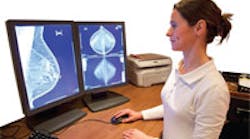Modern mammography systems are widely used, but suffer from limited measurement accuracy. They also are uncomfortable for patients because they involve compressing the breast (Fig. 1). To provide an alternative screening method, Bristol University spinout Micrima has created Multistatic Array Processing for Radiowave Image Acquisition (MARIA). Rohde & Schwarz UK has supplied high-speed vector network analyzers (VNAs) to Micrima for the clinical trials of this revolutionary breast-cancer-screening technique.
The MARIA ultra-wideband (UWB) radio system has been developed based upon a synthetically focused, but real-aperture multistatic radar. It detects tumors by generating high-resolution, three-dimensional (3D) images of the human breast. This technique, which avoids exposing women to x-ray radiation, is fast and inexpensive. It also is expected to identify breast cancer in younger women with a greater degree of accuracy.
Professors Ian Craddock and Alan Preece from Bristol University developed the wideband antenna array, which lies comfortably beneath the breast. The array connects via a switch matrix to the test ports of an R&S ZVT8 VNA, which takes fast frequency sweep measurements from 4 to 10 GHz (Fig. 2). Test signals are transmitted from each element in the multiple-element antenna array, which receives the signal returns in the manner of a radar system.
Theoretically, the system's large aperture and wide bandwidth will allow the collection of reflected and scattered signals from objects as small as 1.7 mm. The transmitted radio-wave signal has a peak power of less than 1 mW. As a result, it does not even come close to the public limits for exposure to radio waves. Post-processing is carried out on a computer using software developed by the research group.
The R&S VZT8 VNAs were chosen for their measurement speed. With parallel data acquisition across 16 receivers, the ZVT8 eight-port network analyzer enabled the researchers to reduce measurement time from a little over 1 min. to 9 s. Because the instrument also can emulate network analyzers from other suppliers, the learning curve for the team using the VNA was reduced as well.
Funding from Micrima has enabled the radar-based breast imaging system to undergo further technical development and clinical trials. The first set of trials, which just concluded, was very successful. They were conducted at Frenchay Hospital's Breast Care Centre in Bristol in collaboration with Dr. Mike Shere as well as Southmead Hospital in Bristol. Micrima's goal is to create a compact, low-cost version of the MARIA system that could be situated in general practice physician's offices in addition to mobile-screening units.


